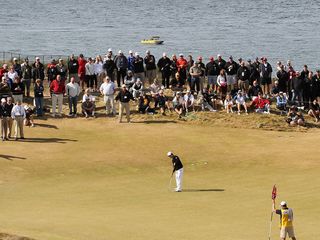US Open: three holes to watch out for
A guide to the three holes to watch out for at the US Open

Chambers Bay, host of the US Open, has many intriguing holes to keep players on their toes.
The US Open buzz is becoming audible, but not for the reasons it normally would be.
Majors talk is traditionally dictated by the players' form and their varying reasons for needing victory. At Augusta National in April, people were fixated by Rory McIlroy's push for the career Grand Slam at the age of 25.
Yet, the primary focus ahead of the year's second major is the course itself. The links course at Chambers Bay has stirred up an almighty storm.
With disparaging and approving comments giving everyone food for thought, we've chosen three holes to look out for that could make or break a player's tournament.
Hole 7 - Humpback - Par 4 - 482 yards
Get the Golf Monthly Newsletter
Subscribe to the Golf Monthly newsletter to stay up to date with all the latest tour news, equipment news, reviews, head-to-heads and buyer’s guides from our team of experienced experts.
As the players line up their irons on the fairway, they better make sure their ball doesn't drop short. Situated just in front of the green are two mounds that will almost certainly stop balls that have plans to roll closer to the pin.
A shot too far right of the mounds is likely to end up in sand. However, making it out of the sand won't necessarily guarantee a shot for par.
The green's uneven surface, typical of the greens at Chambers Bay, means players may be caught out in an attempt to make a birdie or par.
A significant slope to the left of the surface could derail any decent attempt at a putt. People have said that imagination is crucical to playing and succeeding on this golf course. It may just prove to be the accepted fifteenth club.

Hole 10 - High Dunes - Par 4 - 436 yards
The dunes looming large around the green on hole 10 will feel as if they're caving in on a player about to make a pressure putt.
A narrowing fairway, with bunkers lining its banks, reward accuracy and offer little forgiveness to those who are a couple of percent short of their best.
After a routine tee shot, the second shot will be the one to look out for. The fairway narrows, bunkers emerge and the margin for error becomes even thinner than the gap to the green.
It will be fascinating to see how players approach this hole, with wide open spaces at a premium the closer you get to the green.

Hole 15 - Lone Fir - Par 3 - 123-246 yards
There are holes at Chambers Bay that threaten to engulf the green with bunkers, but one comes closer than the rest. That hole is Lone Fir.
The green is surrounded by a large bunker that stretches around three sides. Some will inevitably fall victim to it and aren't necessarily likely to be rewarded for clearing it; a slope carries the ball back towards the bunker.
A bunker to the left of the green is also cleverly positioned. However, par should be manageable for most. A decent shot from the sand could still, depending on pin position, give players an opportunity to take what they've got and move on with nothing lost.

-
 Verne Lundquist Lifts Lid On Emotional Masters Farewell With Tiger Woods
Verne Lundquist Lifts Lid On Emotional Masters Farewell With Tiger WoodsTiger Woods shared a poignant moment with the legendary broadcaster beside the 16th green in the final round at Augusta
By Ben Fleming Published
-
 John Catlin Wins Back-To-Back Asian Tour Titles Whilst LIV Golfer Likely To Remain Outside World's Top 100 Despite Strong Showing
John Catlin Wins Back-To-Back Asian Tour Titles Whilst LIV Golfer Likely To Remain Outside World's Top 100 Despite Strong ShowingThe American cruised to the Saudi Open title by seven shots, while David Puig is likely to stay outside the world's top 100 despite finishing fifth
By Matt Cradock Published